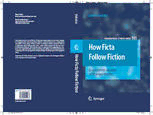
How Ficta Follow Fiction: A Syncretistic Account of Fictional Entities PDF
Preview How Ficta Follow Fiction: A Syncretistic Account of Fictional Entities
Alberto Voltolini 105 PHILOSOPHICAL STUDIES SERIES How Ficta Follow Fiction A Syncretistic Account of Fictional Entities (cid:5)(cid:6)(cid:0)(cid:4) HOW FICTA FOLLOW FICTION Philosophical Studies Series VOLUME105 Founded by Wilfrid S. Sellars and Keith Lehrer Editor Keith Lehrer,University of Arizona, Tucson Associate Editor Stewart Cohen, Arizona State University, Tempe Board of Consulting Editors Lynne Rudder Baker,University of Massachusetts at Amherst Radu Bogdan, Tulane University, New Orleans Marian David, University of Notre Dame John M. Fischer, University of California at Riverside Allan Gibbard, University of Michigan Denise Meyerson, Macquarie University François Recanati,Institut Jean-Nicod, EHESS, Paris Stuart Silvers, Clemson University Barry Smith, State University of New York at Buffalo Nicholas D. Smith, Lewis & Clark College Linda Zagzebski, University of Oklahoma The titles published in this series are listed at the end of this volume. HOW FICTA FOLLOW FICTION A Syncretistic Account of Fictional Entities ALBERTO VOLTOLINI University of Modena and Reggio Emilia, Italy A C.I.P. Catalogue record for this book is available from the Library of Congress. ISBN 10 1-4020-5146-8 (HB) ISBN 13 978-1-4020-5146-3 (HB) ISBN 10 1-4020-5147-6 (e-book) ISBN 13 978-1-4020-5147-0 (e-book) Published by Springer, P.O. Box 17, 3300 AA Dordrecht, The Netherlands. www.springer.com Printed on acid-free paper All Rights Reserved © 2006 Springer No part of this work may be reproduced, stored in a retrieval system, or transmitted in any form or by any means, electronic, mechanical, photocopying, microfilming, recording or otherwise, without written permission from the Publisher, with the exception of any material supplied specifically for the purpose of being entered and executed on a computer system, for exclusive use by the purchaser of the work. To all my fictional friends who have kept me company in writing this book CONTENTS Acknowledgments ix Introduction xiii Glossary xxi Part I The Metaphysical Side Chapter 1: The Committal Theories (I) 3 Chapter 2: The Committal Theories (II) 37 Chapter 3: The Syncretistic Theory 65 Chapter 4: Further Developments of the Syncretistic Theory 101 Part II The Semantic Side Chapter 5: The Noncommittal Theories 127 Chapter 6: The Syncretistic Theory 187 Part III The Ontological Side Chapter 7: An Ontological Argument in Favor of the Existence of Fictional Entities 223 Bibliography 247 Index of Names 255 Index of Subjects 259 vii ACKNOWLEDGMENTS Thirteen years ago, I published in Italian a book called Riferimento e intenzionalità [Reference and Intentionality] (ETS, Pisa 1992), in which I argued for a committal theory on intentional objects as possible entities. Intendedtoliehalfwaybetweentheontologicalproliferationofentitiesàla Meinong and the ontological sobriety defended by Russell from 1905 onwards,thistheoryrecognizedthatwebothrefertoandthinkaboutentities thatdonotexistinsofarastheyareentitiesthatdonotactuallyexist;yetitalso insistedthattheseentitiesmustbethingsthatpossiblyexist.Asaresult,par- adoxicalandcontradictoryitems—inawordimpossibilia—wereruledoutof intentionaliaaswellasoutoftheoverallinventoryofwhatthereis. However, it suddenly occurred to me that prima facie our thoughts “direct”themselvesnotonlyuponthingssuchasthepossibleunactualsonof Elizabeth I and Philip II, but also upon creatures of imagination such as HamletandOphelia,DesdemonaandOthello;thatis,uponfictionalobjects. Sinceentitiesofthiskindmaywellappeartobecontradictoryorparadoxical entities,itishardtorankthemamongpossibleentities.Nonetheless,itseems to be a firm intuition that we think about them as much as about possible unactual entities such as the actually nonexistent complex made up of this jacketandthosetrousers.Soitappearedcleartomethatthetheoryofinten- tionality I had originally developed should be somehow implemented in ordertoaccountalsoforthefactthatwethinkaboutfictionalentities.YetIdid notwantthisthinkingaboutfictionalentitiestoforcemetoacceptallkinds ofwould-beitemsfromtheMeinongianjungle. Asolutioncametomindin1994whenIpublishedapaper,“Fictaversus Possibilia”(GrazerPhilosophischeStudien48,75–104).Inthatpaper,Idrew a distinction between possible and fictional entities. But I included the fic- tionalinthedomainofactualia,asentitiesthatactuallyexistalbeitinanon- spatiotemporalway:thatis,asactualabstractentities.Moreover,Iconceived ix x Acknowledgments of these abstracta as a peculiar kind of complex entity. I imagined that two distinctfactorsledtotheiridentity:asetofproperties,thepropertiesmobi- lizedintherelevantstory,andamake-believegame,thestorytellingprocess inwhichonemakesbelievethatthereisanindividualhavingmoreorlessthe propertieswhichfigureinthatset. For a long while, this idea remained an undeveloped intuition.Yet more andmorereadingoftheliteratureonthesubjectconvincedmethatthelogi- calspaceofthepositionsonfictionalentitiesshouldalsocontainthearticu- lated expansion of that original intuition.A conference I organized on this subject in 2002 at the University of Eastern Piedmont atVercelli, Do Ficta FollowFiction?,gavemetheopportunityofresumingmyoriginalthoughts and comparing them with the opinions of some of the most well-known expertsonthissubject.Ialsobenefitedgreatlyfrompresentingmyongoing ideasinseveralseminarswithstudentsandintalksatconferencesheldinvar- ious universities and institutions (the Jean-Nicod Institute in Paris and the universities of Barcelona, Geneva, Messina, Padua, Palermo, Prague, Sienna, andVercelli). Some preliminary results from all of this work have already been published elsewhere (“How Fictional Works Are Related to Fictional Entities”, in A.Voltolini (ed.), Do Ficta Follow Fiction?, special issueofDialectica57(2003),225–238;“Synkretistickáontologiefiktivníck jsoucen [A Syncretistic Theory of Fictional Beings]” in K. Císaˇr and P. Kot´átko (eds), Text a dílo: prˇípad Menard, (cid:2)(cid:3)(cid:4)(cid:5)(cid:6)(cid:5)(cid:7)(cid:3)(cid:8)-Filosofia Publications, Prague 2004, 223–247; “Names for Ficta, for Intentionalia, and for Nothing”, in M.J. Frapolli (ed.), Saying, Meaning and Referring: EssaysonFrançoisRecanati’sPhilosophyofLanguage,PalgraveMcmillan, Houndmills 2006 (forthcoming)). However, all that material required thor- oughre-elaboration,whichIhopeIhaveprovidedinwhatfollows. I am very grateful to many people for the discussions I had with them on this subject on many different occasions, academic and non. These exchanges helped me to clarify my original intuitions. To name just a few, let me thank Carola Barbero, Tilli Bertoni, Andrea Bonomi, Clotilde Calabi, Roberto Casati, Gregory Currie, Michele Di Francesco, Petr Kot´átko, Paolo Leonardi, Diego Marconi, Cristina Meini, Kevin Mulligan, Ernesto Napoli, Gloria Origgi, Jerome Pelletier, François Recanati, Marco Santambrogio, Barry C. Smith, Paul Tucker, Gabriele Usberti, Kendall Walton, and Edward Zalta. Other people also read and commented on particular parts of the manuscript as it was gradually being written; I learned a great deal from them. In this respect, let me thank primarily Marta Campdelacreu, Eros Corazza, Manuel Garcia-Carpintero, Andrea Iacona, Frederick Kroon, Francesco Orilia, Stefano Predelli, Beppe Spolaore, Amie Thomasson, Achille Varzi, as well as some anonymous referees of previous versions of this book. I am also very grateful to Leigh S. Cauman, former managing Acknowledgments xi editor of the Journal of Philosophy, and to Paul J. Goodrick, lettore of English at the Department of Language Sciences and Comparative Foreign Literatures, University of Milan, for their having made thorough linguistic revisions of a previous version and of the final version of the book respec- tively. But my main acknowledgement goes to a close friend of mine, Marco Nani, who not only read the whole manuscript and tirelessly discussed with me all its different parts, but also came up with the idea of extracting a book from my original intuitions, and encouraged and supported me in the devel- opment of the enterprise. If this book has not remained a possible, or even a fictional, entity, it owes a great deal to him.
